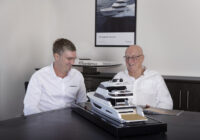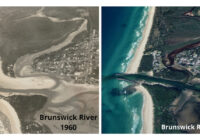Queensland Parliament House was the venue for this year’s Australian Search and Rescue Awards (Awards) event hosted by the Australian Maritime Safety Authority (AMSA) and Queensland Police Service (QPS) on Thursday evening (16 October) in Brisbane.
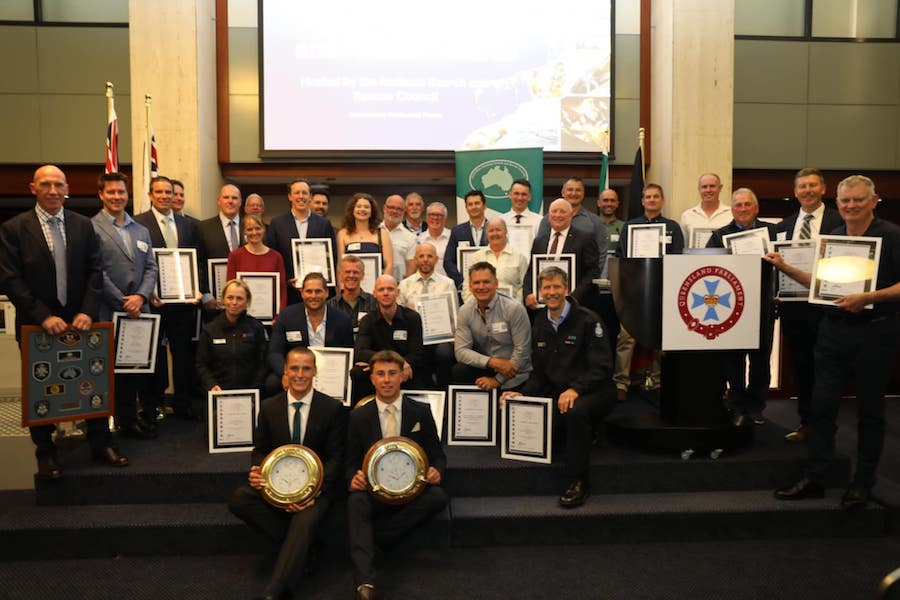
The National Search and Rescue Council (NATSAR Council) presents these awards annually in recognition of ‘outstanding contributions to search and rescue’ in Australia.
Recipients of these awards are selected from nominations by the search and rescue community and members of the public across Australia.
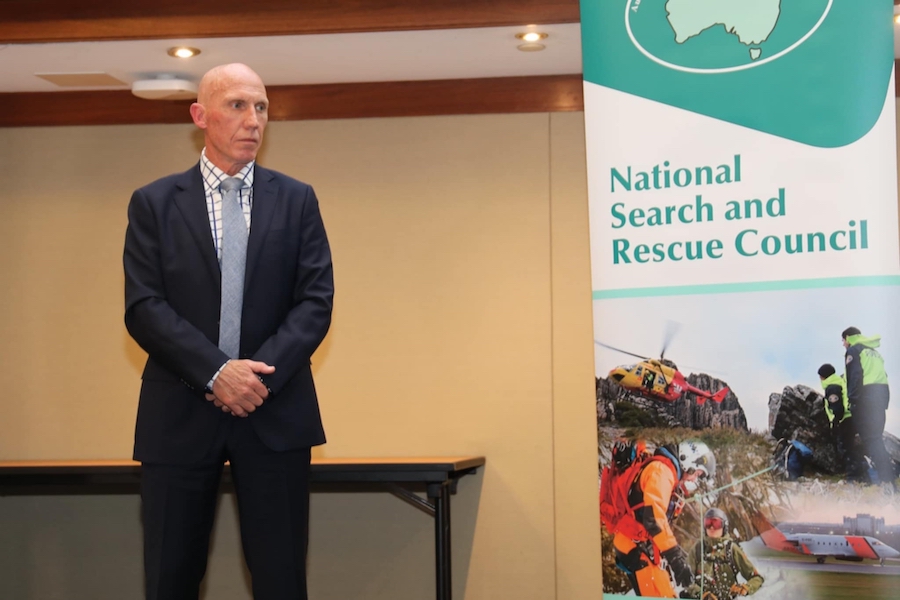
NATSAR Council Chair and AMSA Executive Director Response, Alex Barrell, said the selection process is a challenge, with all nominations outstanding on their own merit.
“The selection process for the Australian Search and Rescue Awards is tough every year, and this year was no exception, as we recognise outstanding contributions to search and rescue at a national level.
“What sets these awards apart is that they are open to both the search and rescue community and the wider Australian public, to nominate and to recognise individuals or groups for their contribution to keeping people safe.
“AMSA is proud of its partnership with the NATSAR Council and the broader search and rescue community and is committed to being a key partner for all,” Mr Barrell added.
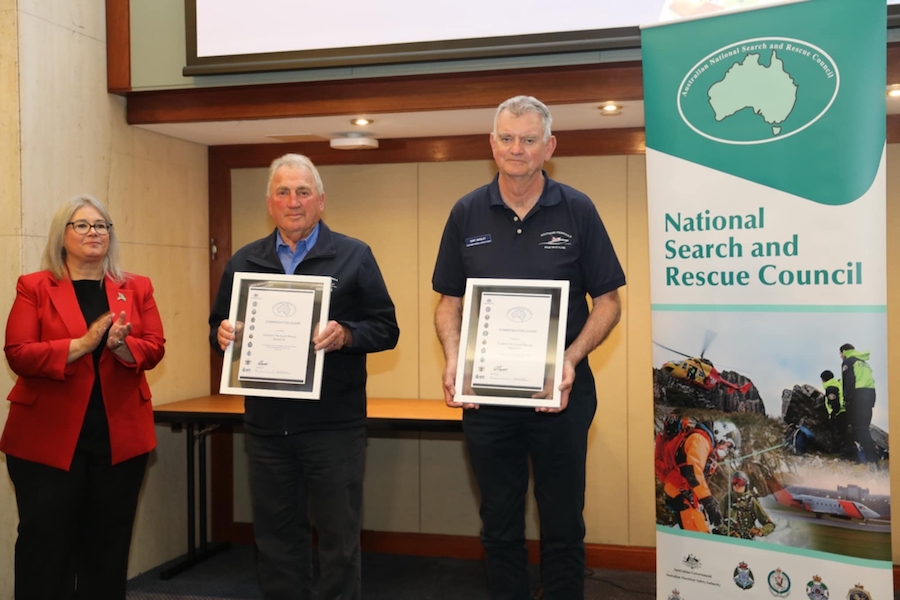
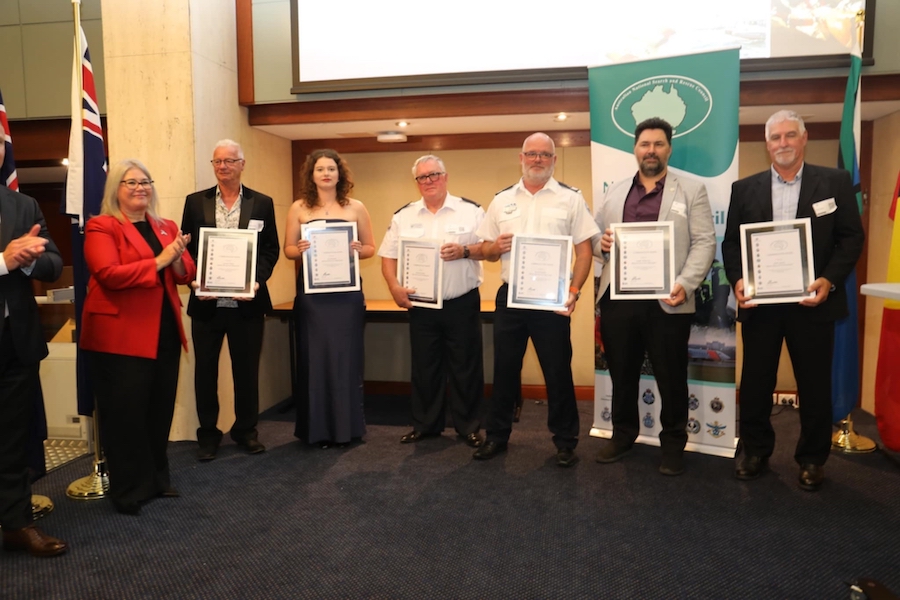
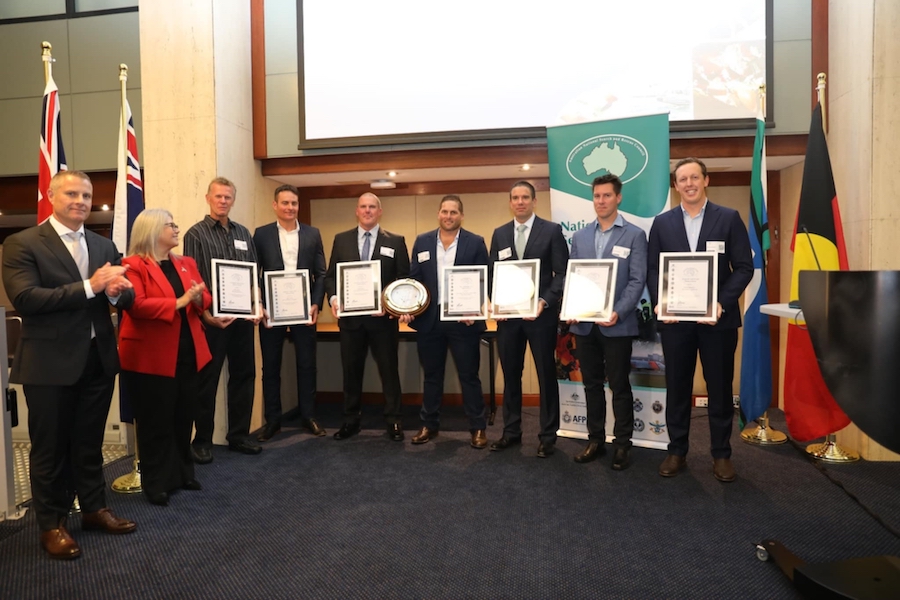
Recipients of the 2025 Australian Search and Rescue Awards:
- Professional Award: Ambulance Tasmania, Tasmania Police, Surf Life Saving Tasmania, Rotor-Lift Aviation – Franklin River, Tasmania – in recognition of an extremely challenging rescue in the Franklin River National Park in November 2024.
- Professional Volunteer Award: Climbers Club of Tasmania Vertical Rescue Team – in recognition of a complex and high-risk rescue operation from Tasmania’s 65-metre-tall Totem Pole Sea Stack in February 2025.
- Non-Professional Awards: Louie Greenland and Remy Roberts – Noosa Heads Queensland – in recognition of their assistance to passengers and crew onboard boat in distress while crossing the Noosa Bar in July 2024.
- Long-Standing contribution Award: Darryl Wright – South Australian State Emergency Service – in recognition of over 30 years of contribution to public safety, marine search and rescue, and volunteer advocacy.
Commendations will also be awarded to:
- Professional (joint awardees):
- Tasmania Police, Ambulance Tasmania and SES Tasmania – for a rescue from the Twin Spires, Tasmania in July 2024.
- New South Wales Police Marine Area Command – for the rescue of two crew from a yacht in the Tasman Sea 185 km east of Nowra, New South Wales in September 2024.
- Professional Volunteer: Marine Rescue Port Macquarie, NSW – for their significant assistance to a cruiser in distress crossing Port Macquarie Bar in May 2025.
- Non-professional(joint awardees):
- Port Phillip Sea Pilots, Point Lonsdale, Victoria – for the rescue of a swimmer in distress near Point Lonsdale in April 2025.
- Professor David Widdowson & Captain Suzanne Rogers, Canberra, Australian Capital Territory – for the rescue of passengers from a sinking charter vessel on Lake Burley Griffin in December 2024.
- Long-standing contribution: Southern Peninsula Rescue Squad, Victoria – for 58 years of service to the Port Phillip Bay community, established following the disappearance of Harold Holt in 1967.
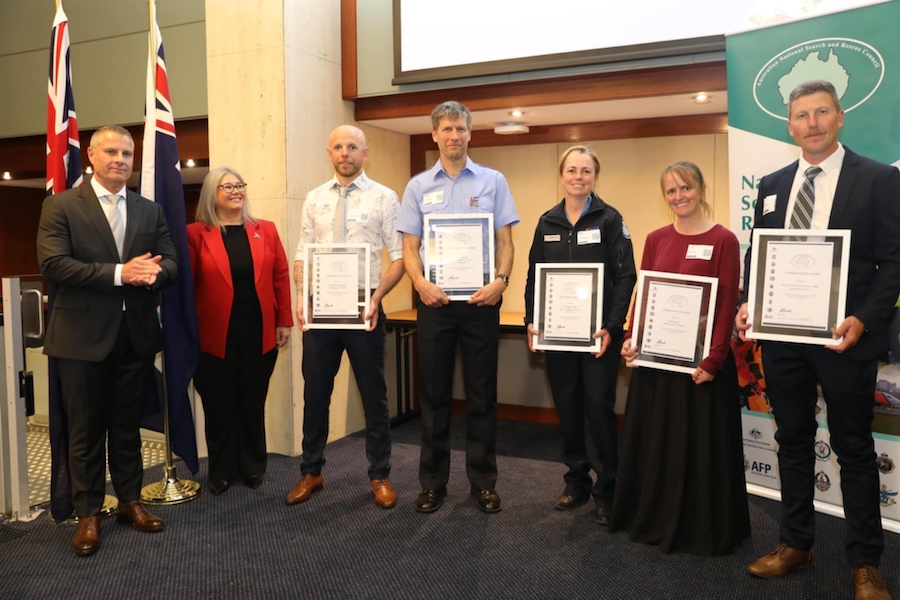
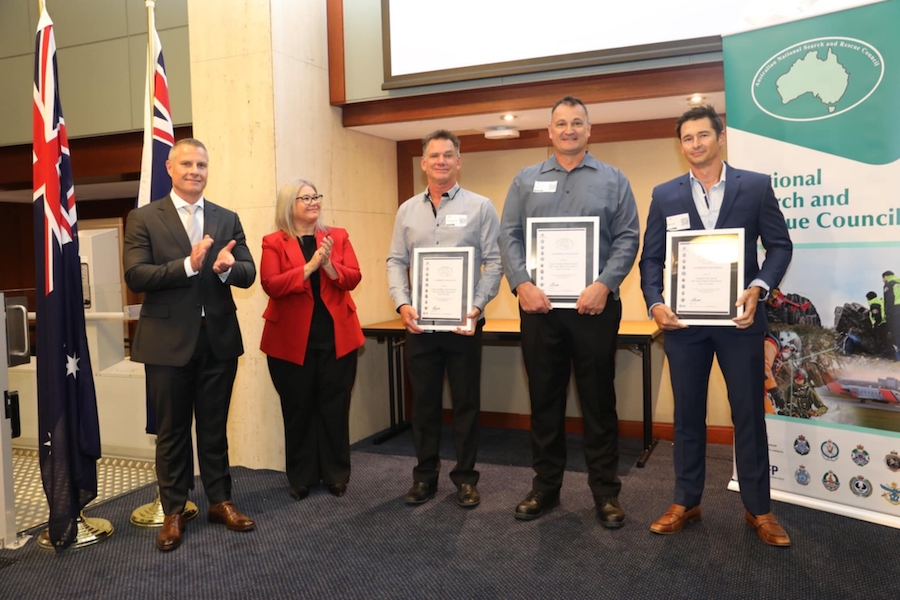
Nominations for the 2026 awards are now open until early July next year, here.
Full descriptions of each award below.
Professional Award
Franklin River National Park rescue, Tasmania
Ambulance Tasmania, Tasmania Police, Surf Life Saving Tasmania, Rotor-Lift Aviation – Franklin River National Park, Tasmania
Important note: This incident involves a medical procedure that may be confronting to some audiences.
On Friday 22 November 2024, Tasmanian Emergency Services were alerted to a beacon activation in the Franklin River National Park, in Tasmania’s south-west wilderness. The beacon activation was received by the Joint Rescue Coordination Centre at the Australian Maritime Safety Authority (AMSA). Tasmania’s south-west is extremely remote, and only accessible by air or a three-day river transit.
The leader of a 10-person rafting group had become trapped in fast-flowing waters. The man’s leg was pinned between rocks in a grade 4-5 section known as Coruscades. After over an hour of attempting to free him, the group called for help.
A rescue helicopter was deployed, winching in Intensive Care Flight Paramedic Mitch Parkinson and Rescue Crew Officer Tim Donovan. After assessing the situation, they quickly called for further support. A second helicopter winched in another Intensive Care Flight Paramedic Rohan Kilham, Retrieval Doctor Nicholas Scott, and two experienced swift-water rescue technicians, Nate Welch and Adrian Petrie, from Surf Life Saving Tasmania.
Adding to the complexity of the situation, communication in the gorge was almost impossible, and the AMSA Challenger rescue aircraft was tasked to provide overhead support, communications aid and situational awareness.
Specialists from Ambulance Tasmania were also winched into the gorge. There were over 19 experts involved on scene, with overhead support.
Throughout the night the patient was monitored and cared for by the medical team. Technicians worked in freezing water, using hydraulic cutters and large capacity hydraulic jacks to try to release the man’s leg. However, he remained trapped.
By the early hours of Saturday, the man’s condition deteriorated, and with hypothermia setting in the medical team determined his only chance of survival was an emergency underwater amputation.
In extremely challenging conditions, Retrieval Consultant Dr Jorian Kippax from Ambulance Tasmania, alongside Intensive Care Flight Paramedics Rohan Kilham and Adam Marmion, performed the complex procedure.
Once freed, the patient deteriorated and was placed on mechanical CPR before being winched from the gorge. Mechanical CPR continued throughout the flight to Royal Hobart Hospital.
It is believed this was the first time winching of a patient, who is intubated and receiving mechanical CPR, has been undertaken in Australia. Rescue helicopters then conducted 43 winches to extract the remaining rafters, medical staff and all equipment from the site.
The patient received extensive care at Royal Hobart Hospital and, after a lengthy recovery, has returned home to Lithuania.
The professionalism and determination of all involved has been highly praised. The mission was one of the most complex and dangerous rescue operations ever attempted in Tasmania’s wilderness. The patient’s survival, against incredible odds, stands as a testament to the skill, dedication and perseverance of all those who operated in an immensely challenging and high-risk environment.
Professional Volunteer Award
Totem Pole Sea Stack rescue, Tasmania
Climbers Club of Tasmania Vertical Rescue Team
On the evening of 12 February 2025, a complex and high-risk rescue operation unfolded at one of Tasmania’s most iconic and challenging natural landmarks – the 65-metre-tall Totem Pole Sea Stack, located off the rugged Tasman Peninsula.
Two climbers became stranded on top of the Totem Pole after rope connecting them to the mainland separated. The climbers were isolated with daylight fading and weather deteriorating.
When Tasmania Police received the emergency call around 6pm, they quickly recognised the rescue would require specialist expertise.
The Climbers Club of Tasmania Vertical Rescue Team is a volunteer unit trained in technical climbing and vertical rescue and was mobilised for the incident. Team leader Chris Hampton coordinated a group of four skilled volunteers to assist.
An initial plan to reach the climbers via helicopter was abandoned due to high winds and incoming cloud cover. A marine approach using a police vessel was also deemed unsafe because of heavy swell, darkness, and rough conditions. The team decided to reach the Totem Pole on foot, hiking for two hours and reaching the cliff base around 1:30am, to enact a ‘bottom up’ rescue.
Once on site, the team assessed the confined rescue area and set up a twin-rope counterbalance system. Members of the team hold climbing and commercial instructional certifications and their expertise was instrumental in evaluating the risks, setting up access lines and a retrieval system.
Crew from the rescue team descended 60 metres to the base of the Totem Pole to establish anchor points and guide the rescue.
The stranded climbers, increasingly affected by the elements, commenced a descent using some of their recovered equipment, but were convinced by the Climbers Club rescue team to wait for the rescue system to be fully prepared.
Once the retrieval system was secured, the climbers were safely lowered in a pendulum swing from the Totem Pole to the mainland cliff and then hauled 50 metres to safety using the counterbalance system.
The operation concluded at 6:30am after a 12-hour rescue. Both climbers were uninjured and expressed deep gratitude for the rescue team’s efforts.
This incident highlights the critical partnership between Tasmania Police and the Climbers Club of Tasmania Vertical Rescue Team, which is a recognised support agency to Tasmania Police.
The operation was executed with precision, adaptability, and a deep understanding of systems and safety protocols. Despite the inherent dangers, every decision was made with careful consideration of weather, terrain, equipment, and team readiness. The Vertical Rescue Team’s professionalism, skill, and composure under pressure were pivotal to the successful outcome.
Non-professional Award
Noosa Heads Bar jet ski rescue, Queensland
Louie Greenland and Remy Roberts
On 3 July 2024, a commercially operated tourist cruise vessel suffered a marine incident while attempting to cross the Noosa Bar. A large wave struck the bow of the vessel, with six passengers and the skipper on board. Two passengers sitting at the bow of the vessel suffered significant impact injuries.
Locals Louie Greenland and Remy Roberts were jet skiing nearby and witnessed the impact, immediately attending to assist. Louie boarded the vessel and immediately took control of the situation, while Remy provided assistance from the water, including keeping Louie’s jet ski from drifting.
Witnesses reported that Louie directed the skipper to move the vessel out of the swell, instructed an adult passenger to call 000, and provided first aid to the injured passengers.
Passengers on board described Remy and Louie’s actions as critical to the safe outcome. One said, “Remy and Louie were incredibly cool-headed and amazing throughout the whole event. They provided a huge amount of support to us all right after the incident and until the injured passengers were taken away by ambulance. Without them, we would have been in a materially worse situation.”
Another added, “We were very grateful for the jet ski boys who came over and helped provide first aid, guidance on where to take the vessel, and reassurance. Their calm presence and knowledge of the area were invaluable in getting us back to safely.”
The vessel was guided back to the marina, with Louie and Remy continuing to assist until Queensland Ambulance Service personnel arrived. Both injured passengers were stabilised and taken to hospital for treatment.
Authorities have commended Louie and Remy for their actions, first aid knowledge, and understanding of the local bar conditions. Their actions demonstrate the importance of quick thinking and calm leadership when faced with a maritime emergency.
Longstanding Contribution to search and rescue
30+ years of search and rescue service
Darryl Wright
Darryl Wright has dedicated over four decades to public safety, marine search and rescue, and volunteer advocacy. Beginning his career with South Australia Police in 1981, Mr Wright served in operational and investigative roles before joining the Water Operations Unit in 1992 as a marine search and rescue operative and diver.
Over the following 14 years, Daryl progressed from vessel crew member to Master and Diving Supervisor and completed the National Search and Rescue Police Managers Course, (NATSARMC), qualifying as a Search and Rescue Mission Coordinator. In this role, Mr Wright led numerous complex and high-profile search and rescue operations, including the 2000 Whyalla Airlines incident.
From 2001, Daryl contributed as a member of the directing staff on the NATSARMC, eventually becoming Course Director in 2005, shaping development of search and rescue capabilities nationwide.
In 2006, Mr Wright transitioned to the South Australian Government as Manager of Volunteer Marine Rescue and Water Safety, where he has been responsible for the strategic management of six Volunteer Marine Rescue associations and the marine capabilities of the State Emergency Service.
As Chair of Volunteer Marine Rescue South Australia, Mr Wright works tirelessly to establish sustainable frameworks to support marine rescue volunteers and advocate for their interests.
In 2010 Mr Wright became a founding member, and South Australian delegate, to the National Volunteer Marine Search and Rescue Committee, later becoming the Chair in 2014. In these roles, Mr Wright has represented marine rescue volunteers at the highest levels, including the Australian Emergency Management Volunteer Forum, the Australian and New Zealand Safe Boating Education Group, and the National Search and Rescue Council.
Through his extensive operational experience and leadership, Mr Wright has demonstrated unwavering commitment to community safety, capacity building and volunteer support. His service exemplifies dedication and passion for advancing marine search and rescue and volunteer representation across both South Australia and Australia.
Mr Wright was also awarded the Emergency Services Medal during the 2025 Australia Day Honours.
Professional Commendation (joint recipients)
Twin Spires rescue, Tasmania
Tasmania Police, Ambulance, State Emergency Service
On the afternoon of Sunday 14 July 2024, Tasmanian police received a distress alert from a personal locator beacon via the Joint Rescue Coordination Centre at the Australian Maritime Safety Authority. The beacon activation occurred in the Twin Spires area, an isolated and rugged peak within the Walls of Jerusalem National Park.
A family of three, a couple with their nine-year-old son, had set off on a day walk and summited the peak earlier in the day. With deteriorating weather setting in, 14 kilometres still to cover and no provisions for an overnight stay, the family activated their emergency beacon.
By late afternoon, conditions had worsened with snow and gusty winds. Cold, wet and exhausted, the family huddled under a pencil pine inside a plastic survival bag. As they waited for help, all three walkers became hypothermic, with the young boy increasingly unresponsive.
Tasmania Police Search and Rescue Controller, Senior Sergeant Michael Gillies, coordinated an urgent response. Poor weather ruled out helicopter access, and so a ground team of rescuers set off from the trailhead. They faced rising rivers, thick snow and blizzard conditions, with wind chill as low as minus 11 degrees during the 14-kilometre walk.
Rescuers located the family in their makeshift shelter at 2am. The child was in a critical condition with a core body temperature of 30 degrees. The rescue team quickly established shelter, then dried and re-clothed the family, and provided food and warm drinks. The team remained on scene for 36 hours, providing care and support until weather cleared and a helicopter evacuation became possible.
A second search team was also deployed that night but was unable to reach the family due to swollen rivers.
This was an incredibly challenging rescue in extreme conditions. The three walkers have made a full recovery. Medical experts have confirmed that, without the team’s rapid intervention, the outcome could have been very different. The training, skills and endurance of the rescue team is being recognised.
This incident is also a testament to the critical importance of using a distress beacon in remote locations.
Tasman Sea rescue, New South Wales
New South Wales Police Marine Area Command
On Monday 2 September 2024, multiple distress beacon alerts were received by the Joint Rescue Coordination Centre at the Australian Maritime Safety Authority, from a location approximately 100 nautical miles east of Nowra, NSW. The alerts were tracked to sailing yacht Spirit of Mateship, with two people on board.
The pair had departed Jervis Bay the previous day, bound for Brisbane via Sydney when their vessel began taking on water. They had also suffered a rigging failure and began drifting further out to sea.
NSW Police launch Nemesis was deployed from the Marine Area Command in Sydney, crewed by Senior Sergeants Michael Morris and Michael Hrnjak, Sergeant Ryan Spong, Senior Constables Lincoln Kilpatrick, Scott Kelly and Russell Bateman, and Constable Jason Burnett. The Police Launch left at 2:20pm, making way through seas up to eight metres and wind gusts exceeding 60 knots, to the yacht’s last known position.
The rescue mission was supported by Navy ships HMAS Canberra and HMAS Arunta, along with a RAAF C-130 aircraft. At 1am on Tuesday, HMAS Canberra located the stricken yacht 240 km southeast of Sydney. The extreme conditions made it impossible to launch tenders at that time.
By 3am, Nemesis and HMAS Canberra had also arrived at the drifting yacht. Darkness and severe weather made a night-time rescue too dangerous, and crews agreed to wait until first light.
At dawn, HMAS Canberra created a lee (blocking wind and waves) to shield the Nemesis from the worst of the seas. This allowed NSW Police to deploy a tender, crewed by Sergeant Spong and Senior Constables Kelly and Bateman. In extremely hazardous conditions, the officers made repeated approaches to the yacht, timing each attempt with precision to safely retrieve both sailors, before successfully accomplishing the rescue.
Nemesis returned to the Marine Area Command at 6:30pm on Tuesday, 30 hours after setting out.
This was an extraordinary rescue carried out in extreme conditions. The professionalism and maritime skill of the crew — particularly Sergeant Spong and Senior Constables Kelly and Bateman — ensured two lives were saved.
NSW Police Marine Area Command acknowledges the assistance provided by the Australian Maritime Safety Authority and the Australian Defence Force in this complex operation.
Professional Volunteer Commendation
Port Macquarie bar rescue, New South Wales
Marine Rescue NSW Port Macquarie
Mid-morning on 14 May 2025, a 15-metre motor cruiser with one person on board, experienced critical mechanical failure while crossing the notorious Port Macquarie Bar.
The skipper deployed the anchor to prevent the boat drifting onto nearby rocks, but the cruiser became trapped in one of the bar’s most hazardous sections.
Marine Rescue Port Macquarie vessel PM30 was training nearby and quickly responded. The crew faced challenging conditions and after four attempts were able to secure a tow line.
However, the cruiser’s anchor could not be recovered, and the tow was released because of to the danger of the rescue vessel remaining in the swell zone of the bar.
The cruiser had dragged anchor into a more dangerous location, however the new position meant severing the anchor was likely to allow the cruiser to drift safely out of the bar. The Marine Rescue crew transferred large bolt cutters via a heaving line. The anchor chain was cut and the cruiser drifted to safety.
The rescue crew re-established the tow and successfully positioned it outside the surf zone.
A Marine Rescue crew member boarded the cruiser and was able to restart one engine. With support from the Marine Rescue vessel, the cruiser was guided across the bar and returned to the marina.
The three-hour rescue was resolved without injury or loss of vessel, thanks to the fast response, calm professionalism, and seamanship of the Marine Rescue volunteers. The volunteers involved showed skill, adaptability, persistence and composure under pressure.
Non-professional Commendation (joint recipients)
Point Lonsdale rescue, Victoria
Port Phillip Sea Pilots
On 5 April, Lonsdale Vessel Traffic Services (VTS) contacted the crew of a Port Phillip Sea Pilots vessel, reporting a kayak in distress and swimmers washed outside of Point Lonsdale. Seas were over three metres, and winds at 20 knots.
Michael Randall and Grant Jordan, aboard the pilot vessel, decided to return through Port Phillip Heads from a south-easterly directions, as they had concluded the tide would most likely send a swimmer in that direction.
Approximately 2.4km south of Point Lonsdale, in the West Shipping Channel, Michael and Grant spotted a woman in the water. The crew implemented standard ‘person overboard’ procedures and successfully retrieved the swimmer, who was found to be mildly hypothermic and in shock. The woman indicated another swimmer nearby wearing a pink cap.
The two sea pilots continued searching for approximately 45 minutes with assistance from the Victoria Police Air Wing, maintaining communication via VHF radio. Ports Victoria confirmed all swimmers were accounted for, and the crew returned to Queenscliff Harbour, where paramedics were waiting.
Authorities commended Mr Randall and Mr Jordan for their calm, decisive actions, noting that their care of the hypothermic swimmer — including managing her body temperature and providing support while in the water — undoubtedly saved her life.
It is important to note, this nomination is one component of a broader search and rescue effort coordinated by Victoria Police, involving multiple professional and volunteer assets, and rescuing 12 swimmers in total.
Lake Burley Griffin charter vessel rescue, ACT
Professor David Widdowson and Captain Suzanne Rogers, Debbie Lee tug On 22 December 2024 an emergency on Lake Burley Griffin, ACT, was averted thanks to the quick action of two bystanders and the skipper of a small tug, the Debbie Lee.
The incident began when a commercial passenger vessel began taking on water, with more than ten passengers on board. The call for help was received by a six-metre traditional tug, Debbie Lee.
Professor David Widdowson and commercial aircraft pilot Captain Suzanne Rogers were in the vicinity of the Debbie Lee and immediately volunteered to assist. At full speed, Debbie Lee proceeded the length of Lake Burley Griffin preparing for what might be ahead.
The passenger vessel was found low in the water and the priority quickly shifted from towing to evacuating passengers. As the vessel began to sink, David and Susan helped the passengers board the vessel safely, who were by that stage, in the water.
Displaying remarkable composure, Professor Widdowson entered the cold lake to recover a child and ensure no one was trapped in the sinking vessel. Captain Rogers coordinated communications with Water Police and stabilised the passengers.
All passengers were safely transferred to a police vessel and brought ashore without injury. Authorities praised the volunteers’ calm, selfless and decisive action.
Longstanding Contribution to Search and Rescue Commendation
58 years’ service to Mornington Peninsula, Victoria
Southern Peninsula Rescue Squad
The Southern Peninsula Rescue Squad was born in 1967, sparked by the disappearance of Australian Prime Minister Harold Holt at Cheviot Beach. This tragedy, combined with a rise in boating incidents on Port Phillip Bay, exposed a lack of emergency resources on the then-remote Mornington Peninsula.
By 1970, this grassroots effort officially became the Southern Peninsula Rescue Squad – a volunteer-led organisation committed to marine search and rescue.
For years, they also provided helicopter rescue services, owning a series of aircraft until 2010, when operations shifted fully to marine rescue due to changing needs and resources.
In 2012, the squad’s base moved to Blairgowrie Yacht Club, enhancing ability to respond swiftly to marine emergencies.
The 35 plus volunteers in the Squad are the driving force behind every mission, responding with practical skills gained through rigorous training. The volunteers operate search and rescue vessels in often dangerous waters, administer first aid under pressure, and navigate a rugged coastline.
The Southern Peninsula Rescue Squad also operates a very successful Opportunity Shop to fund the running of a Marine Rescue organisation. The shop is run by over 50 volunteers.
The squad also participates in many local events, providing rescue services for the famous Portsea Swim Classic, the Sorrento Swim, Portsea Pier to Perignon, the Melbourne to Hobart Yacht race, the Melbourne to Osaka Yacht race and the Sorrento Ultra Marathon Swim.
The Southern Peninsula Rescue Squad provides education and experiences to children who attend the not-for-profit Portsea Camp for children and also addresses Surf Lifesaving camps at Portsea Surf Life Saving Club.
For over 58 years, Southern Peninsula Rescue Squad has thrived to become a well-respected volunteer organisation and a vital part of the community.







